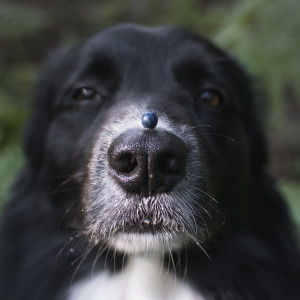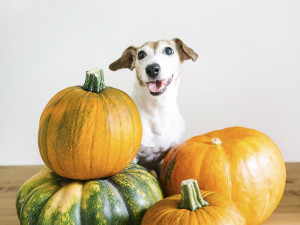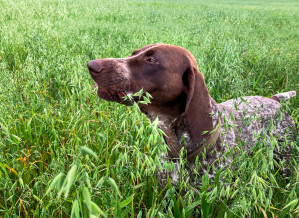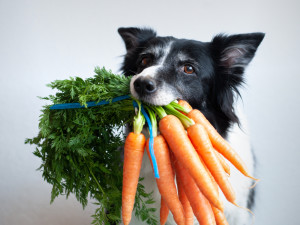10 Fruits and Vegetables That Your Dog Can Feast On
Indulge your pup (safely) with these delicious and healthy snacks.

share article

Your pet wants you to read our newsletter. (Then give them a treat.)
Sharing food with your dog might seem radical, but it’s actually the way dogs were fed for millennia. The bond people developed with dogs is partly because dogs and humans could eat the same foods, and the act of sharing reinforced this unique connection (as they taught us in kindergarten: sharing is caring). But not all foods are safe for dogs, so it’s crucial to know which fruits and vegetables are recommended. Here are 10 healthy, sharable fruits and veggies for you and your pup.
A few words of caution: First, it might seem obvious, but none of these fruits and veggies by themselves constitutes a “complete and balanced” meal. If your dog has any health or weight issuesopens in a new tab, check with your vet before introducing new snacks. As with any new food, gradually start with a small portion to see if it’s something your dog enjoys and tolerates on the, umm, digestive sideopens in a new tab. With those caveats, here are 10 healthy fruits and vegetables that are safe to share with your dog.
1. Banana
Bananas are a good source of potassium for dogs. Potassium is good for muscle building and blood vessel function and helps regulate the acidity of a dog’s body fluids. Bananas have lots of pyridoxine (vitamin B6), which helps metabolize proteins and regulates blood cell function so the blood can bring more oxygen to the brain and muscle. They also contain vitamin C, an antioxidant that protects a dog’s cells from damage and helps build cartilage.
How to add bananas to your dog’s food
There are many ways to give bananas to your dogopens in a new tab, but the most basic method is simply to mash a bit of banana and mix it with your dog’s food. Note: The compounds in bananas that make them smell banana-y are offensive to some pups.
2. Rutabaga
A sorely ignored vegetable, the rutabaga is a healthy veggie for dogs. Rutabagas are very good boiled and mashed. They’re available all year in most grocery stores and keep well. Their high levels of vitamin C, potassium, and carotenoids (precursors to vitamin A) help improve eye health and the maintenance of DNA activation in cells. Rutabagas are also important in a dog’s immune system function and have a number of lesser-known phytochemicals, which are shown to reduce the risk of several chronic diseases associated with aging and help fight canceropens in a new tab.
How to add rutabaga to your dog’s food
Peel, boil and mash the rutabaga, then add a little bit of safflower or olive oil; these oils are not harmful to dogs, who need fats and handle them far better than people.
3. Sweet Potato
Dogs love sweet potatoes, and with good reason. Sweet potatoes are loaded with nutrients, such as carotenoids and Vitamin C, in addition to some lesser-known antioxidants and phytochemicals. They are high in pyridoxine, potassium, fiber, and magnesium. Sweet potatoes are also good sources of copper, iron and manganese — essential minerals that perform myriad functions in cells, from transporting oxygen to assisting in the assembly of proteins.
How to add sweet potato to your dog’s food
As with rutabaga, a simple way to introduce them is to boil, then mash and add a bit of good oil. Dogs also love this sweet potato chipsopens in a new tab recipe.
4. Carrots
Carrots are a great dog snack; they’re crunchy, sweet, and most dogs really like them. They are loaded with carotenoids, fiber, Vitamin C, and Vitamin K (needed for blood clotting), as well as potassium. Carrotsopens in a new tab have magnesium, manganese, most of the B vitamins, and phosphorus, which is required for energy production, among other things.
How to add carrots to your dog’s food
Start out slowly; too much fiber may cause your dog to get a bit gassyopens in a new tab. If your pup isn’t interested, try soaking lightly steamed carrots in chicken broth to increase their appeal.
5. Green Beans
This veggie makes a perfect addition to any pup’s dinner. Some dogs love raw green beans, but most prefer them blanched, which makes for easier digestion. An excellent source of Vitamin K and fiber, these veggies also contain vitamin C, carotenoids, potassium, B vitamins, magnesium, phosphorus, copper, iron, and manganese.
How to add green beans to your dog’s food
Blanch green beans before serving to your pup. Boiling green beans will lose all of their beneficial nutrients.
6. Papaya
Readily available in most markets, papayasopens in a new tab, also known as papaws, are loved for their sweet taste and vibrant color. This tropical fruit contains papain, an enzyme often used as a meat tenderizer. It assists in the breakdown of proteins and thus is considered a “digestive aid.” Ripe papaya is an excellent source of carotenoids and potent antioxidants and is also high in vitamin C, most of the B vitamins, potassium, magnesium, and fiber. These nutrients benefit a dog’s eye health, blood vessel integrity, and joint function.
How to add papaya to your dog’s food
Scoop out the ripe papaya and serve it as a snack to your pup. Be sure to remove the seeds. While edible, papaya seeds have a peppery flavor that may be too much for your dog.
7. Pumpkin
This gourd is low in calories and high in soluble fiber. Pumpkin makes a nice treat for a pup with an upset tummy and also helps resolve bouts of diarrheaopens in a new tab. It is low in sodium and exceptionally high in carotenoids, potassium, and vitamin C and has some calcium and B vitamins. Pumpkin can be used as a fat substitute when making dog treats.
How to add pumpkin to your dog’s food
Steam and mash fresh pumpkin for your pup,opens in a new tab or take the easy way out and use canned pumpkin (organic, if possible). If using canned, read the label carefully to be sure you’re getting 100 percent pumpkin, not pumpkin pie filling, which has added salts and sugars.
8. Blueberries
Blueberries are available all year, either fresh or frozen and loaded with phytochemicals. They are an excellent treat for your dog. The deep blue color comes from anthocyanidins, which are potent antioxidants, and the berries also supply vitamin C, vitamin E, manganese, and fiber. Slow introduction in small quantities is particularly essential here. Gorging on this tasty fruit can cause a potential stomach ache for both pups and people.
How to add blueberries to your dog’s food
Rinse and serve whole, mash lightly, or try out this simple four-ingredient blueberry dog treat recipeopens in a new tab.
9. Turnip Greens
Unfamiliar to many people and dogs alike, turnip greens are an excellent source of vitamin K, vitamin C, carotenoids, most B vitamins, fiber, and manganese. They are also a good source of calcium, copper, potassium, magnesium, and phosphorus and provide a complement of antioxidants. Turnip greens are bitter and contain appreciable amounts of oxalates that can bind minerals, and goitrogens, which may interfere with thyroidopens in a new tab function in susceptible pups — so check with your veterinarian.
How to add turnip greens to your dog’s food
To minimize these effects and maximize palatability, sauté or blanch. Most recipes call for sautéing, which maintains the greens’ nutritional density and increases the odds that your dog (and you) will eat these healthful veggies.
10. Swiss Chard
Chard is a pretty veggie, which belongs to the same family as beets and spinach, known for its dark leafy greens and brightly colored stems. Chard is a great food to add to your dog’s menu because it has tons of nutrients, which are best kept by blanching and not boiling the leaves and stalks to mush. (Some feel that, in order to lap up any leeched nutrients, the water in which chard is blanched should be consumed, too.) Blanching sweetens the leaves and frees up some of the oxalates, which can bind minerals. Chard’s nutrients have the potential to maintain your dog’s bone health, blood vessel integrity, eye health and immune function and benefit optimal muscle function and energy production.
How to add chard to your dog’s food
Give your dog some blanched, chopped chard enhanced with a bit of olive oil; if you’re lucky, your best friend will want the blanching water, too.
Roschelle Heuberger, PhD
Roschelle Heuberger, PhD, is a Registered Dietitian, an Associate Professor of Nutrition and director of the Clinical Nutrition graduate program at Central Michigan University.
Related articles
- opens in a new tab
Can Dogs Eat Pumpkin?
Yep! The superfood is a delicious natural remedy for diarrhea and constipation.
![Puppy eating a bowl of blueberries]() opens in a new tab
opens in a new tab10 Superfoods to Share With Your Dog
From kale to quinoa, these nutrient-packed picks deserve a spot in your dog’s food bowl.
![Kurzhaar's dog eats grass, oats, happy puppy playing in the meadow]() opens in a new tab
opens in a new tabWhy Do Dogs Eat Grass?
Your pup is literally vegging out — when it’s NBD and when to worry.
![collage of dog food toppers on blue background]() opens in a new tab
opens in a new tab9 Food Toppers That Will Make Your Dog Actually Want to Eat Dinner
If your dog suffers from mealtime boredom, spice up their food bowl with one of these tasty toppers.
![Dog biting into a bunch of carrots]() opens in a new tab
opens in a new tabHow to Get Your Dog the Vitamins and Minerals They Need
Your pup needs their greens, too.
![A woman and a dog wearing matching green colors and smiling for a picture.]() opens in a new tab
opens in a new tabAllison Fogarty’s Freeze-Dried Dog Treats Are a Delight
Meet the chef with Down syndrome who overcame multiple surgeries to launch her own all-natural dog treat company.











